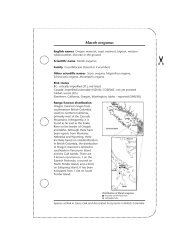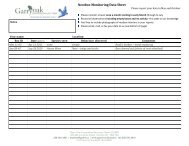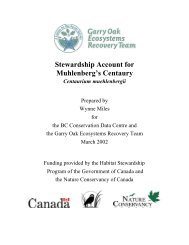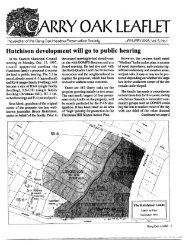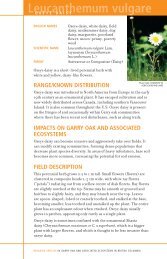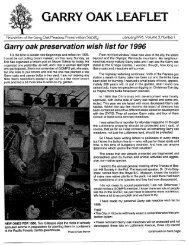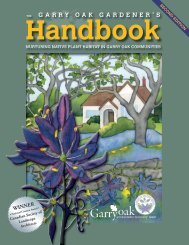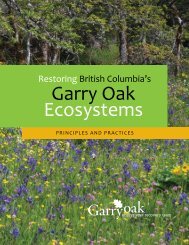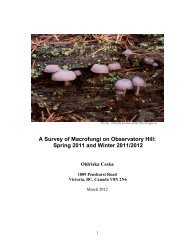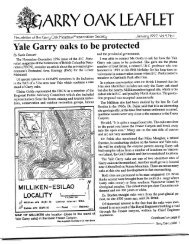PDF 2MB - Garry Oak Ecosystems Recovery Team
PDF 2MB - Garry Oak Ecosystems Recovery Team
PDF 2MB - Garry Oak Ecosystems Recovery Team
Create successful ePaper yourself
Turn your PDF publications into a flip-book with our unique Google optimized e-Paper software.
W H AT I S NEED E D ?<br />
Only a concerted, long-term effort to conserve what remains of<br />
our <strong>Garry</strong> oak ecosystems can halt the ever-increasing threat to<br />
these endangered species. Participation on all levels is essential —<br />
from decision-makers incorporating conservation into planning<br />
processes, to concerned citizens removing invasive species from<br />
neighbourhood parks.<br />
W H AT I S T H E GAR RY O A K ECOSYS T E M S<br />
RECO V E RY T E A M ?<br />
We are a partnership of dozens of agencies and individuals. Our<br />
members and partners include all levels of government, First<br />
Nations, academic institutions, land trusts, land managers,<br />
scientists, naturalists, and others.<br />
n the rainshadow of the Vancouver Island Ranges, one of<br />
Canada’s richest ecosystems is also one of its most<br />
endangered. British Columbia’s <strong>Garry</strong> oak ecosystems<br />
harbour more than 100 species of plants and animals at<br />
risk. Several species have already been eliminated.<br />
Today, less than 5% of <strong>Garry</strong> oak ecosystems remain in a<br />
near-natural condition. The <strong>Garry</strong> <strong>Oak</strong> <strong>Ecosystems</strong><br />
<strong>Recovery</strong> <strong>Team</strong> is working to save these endangered<br />
species and the habitats they need for survival.<br />
W H AT A R E W E DOI N G ?<br />
• We drafted a 5-year <strong>Recovery</strong> Strategy to save <strong>Garry</strong> oak and<br />
associated ecosystems, and help individual species at risk to<br />
survive and thrive<br />
• We are filling information gaps about the ecosystems and<br />
species to determine how to save them<br />
• We are taking active steps to protect and restore habitat for<br />
species at risk<br />
• We are encouraging stewardship by private individuals and<br />
agencies to save endangered species and the habitat they need<br />
MAP COURTESY OF THE PROVINCE OF BRITISH COLUMBIA © 1993<br />
Prior to European settlement, fire played an important<br />
role in <strong>Garry</strong> oak ecosystems. Lightning caused some fires,<br />
but many were set by First Peoples to enhance the growth<br />
and productivity of resources such as camas plants, a food<br />
source. These fires helped create and maintain the<br />
meadows vital to grassland plants and animals that need<br />
open habitats.<br />
DESIGNED BY BEACON HILL COMMUNICATIONS GROUP PRINTED ON 100% RECYCLED PAPER<br />
W H AT CAN Y O U D O T O HELP?<br />
• Learn more about GOERT’s recovery program from our<br />
website: www.goert.ca.<br />
• Make a donation or consider leaving a bequest to GOERT in your<br />
will. Call us at 250-383-3427 for information.<br />
• Encourage and support government initiatives to protect <strong>Garry</strong><br />
oak ecosystems and species at risk.<br />
• Support land conservancies in their efforts to acquire land for<br />
protection or sign a covenant to protect your patch of <strong>Garry</strong> oak<br />
ecosystem forever.<br />
• Remove invasive species and plant nursery-propagated native<br />
plants in your yard.<br />
• Treasure and respect our natural and wild areas in our yards,<br />
parks and all public and private lands.<br />
PHONE: (250) 383-3427 | EMAIL: INFO@GOERT.CA<br />
WEBSITE: WWW.GOERT.CA<br />
PHOTO: HANS ROEMER<br />
PHOTO: HANS ROEMER<br />
in the b e g i n n i n g<br />
In Canada, <strong>Garry</strong> oak ecosystems occur only in British<br />
Columbia — almost exclusively within a narrow coastal<br />
strip of southeast Vancouver Island, in the nearby Gulf<br />
Islands, and in two small stands in the Fraser River Valley.<br />
Arising during a warm interval 7,000 to 10,000 years ago,<br />
<strong>Garry</strong> oak ecosystems once covered a much greater area<br />
than they do today.
what is spec ial ab out garr y oak ec osystems?<br />
what are invasive spec ies?<br />
Unsurpassed beauty and rich biological diversity are hallmarks<br />
of <strong>Garry</strong> oak ecosystems. Intense blue camas blossoms, stunning<br />
pink shooting stars, and blazing yellow western buttercups<br />
appear in spring. Golden grasses wave in summer breezes. In fall<br />
<strong>Garry</strong> oak trees shed their leathery leaves, revealing intricately<br />
gnarled branches cloaked with lichens, liverworts and mosses<br />
that brighten in winter rains.<br />
Interspersed among <strong>Garry</strong> oak ecosystems are other<br />
D E LT O I D<br />
BAL SAM R O O T<br />
PHOTO: HANS ROEMER<br />
ecosystems that also support many of the same plant and animal<br />
species, but lack <strong>Garry</strong> oaks. These include grasslands, rocky<br />
habitats such as coastal bluffs, and former oak ecosystems that are<br />
now dominated by other tree species.<br />
Together, these ecosystems are home to more plant species<br />
than any other terrestrial ecosystem in coastal British<br />
Columbia. Many of these species occur nowhere else in Canada.<br />
more than<br />
100 species<br />
at risk<br />
Non-native (exotic or alien) plant and animal species,<br />
introduced into an ecosystem where they did not previously<br />
live, are considered invasive when they spread aggressively and<br />
impact native species. Whether introduced by well-intentioned<br />
gardeners or accidentally imported, biological invaders are a<br />
serious ecological problem. A few of the many invasive plant<br />
and animal species in <strong>Garry</strong> oak ecosystems include:<br />
I N VA S IVE P L A N T S Shrubs such as Scotch broom, gorse,<br />
English ivy and daphne pose serious threats to <strong>Garry</strong> oak<br />
ecosystems. Orchard-grass, sweet vernalgrass and other exotic<br />
grasses also dominate and degrade many <strong>Garry</strong> oak sites.<br />
I N VA S IVE I NVE RT EBR AT E S Four invasive insects —<br />
the winter moth, jumping gall wasp, oak leaf phylloxeran and<br />
gypsy moth — have caused, or have the potential to cause,<br />
serious damage to <strong>Garry</strong> oak trees. Exotic black slugs dine on<br />
native plants, including species at risk.<br />
I N VA S IVE V E RT E B R AT E S European starlings have<br />
been implicated in the decline of native cavity-nesting bird<br />
species such as western bluebirds. Eastern grey squirrels may<br />
compete with native animals for acorns.<br />
Visit the GOERT website (www.goert.ca) for more<br />
information about managing invasive species.<br />
W E S T E R N<br />
B L U EBIR D<br />
PHOTO: DON MCPHEE<br />
S HAR P -TA I L E D<br />
S N A K E<br />
PHOTO: KRISTIINA OVASKA<br />
TOW N S END ’ S<br />
B IG-E A R E D B AT<br />
PHOTO: BROCK FENTON<br />
ecosystem<br />
TAY L O R ’ S<br />
CHE C K E R S P O T<br />
PHOTO: CRISPIN GUPPY<br />
GOL D E N PA I NTB R U S H<br />
PHOTO: LEAH RAMSAY<br />
…all the living things in<br />
an ecological community, together<br />
now…threatened<br />
Over the past 160 years, most of the <strong>Garry</strong> oak woodlands<br />
have been cleared and converted for agricultural, residential<br />
and industrial development. Now, less than 5% of the<br />
original <strong>Garry</strong> oak ecosystems remain in a near-natural<br />
condition, and these areas are also threatened.<br />
B E A RDE D<br />
O W L -CLOV E R<br />
PHOTO: HANS ROEMER<br />
Threats include habitat loss, fragmentation of larger areas into<br />
smaller, more vulnerable patches, encroachment of woody<br />
species as a consequence of fire suppression, and invasion by<br />
exotic species that outcompete native species. As a result, more<br />
than 100 species of plants and animals that live in <strong>Garry</strong> oak<br />
ecosystems are designated by the BC government as “at risk.”<br />
with the physical environment.<br />
C O A S TA L<br />
V E S P E R S PA R R O W<br />
PHOTO: SUZANNE BEAUCHESNE<br />
in the future<br />
<strong>Garry</strong> oak and associated ecosystems may play an<br />
increasingly important role in Canada with the progression<br />
of global climate change. Species in these ecosystems are<br />
adapted to a warm climate with an extended summer<br />
drought. We need comprehensive conservation strategies to<br />
ensure that all of the resident species survive to spread into<br />
new sites if they become available. <strong>Garry</strong> oak ecosystems<br />
may well be part of the landscape of the future.




